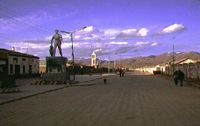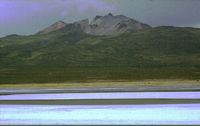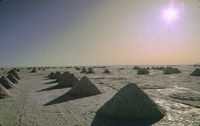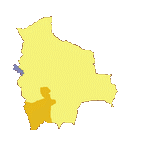Uyuni the phantom city
 A peaceful little town of about 11,000 inhabitants located in the department of
Potosí.
Uyuni
A peaceful little town of about 11,000 inhabitants located in the department of
Potosí.
Uyuni ![]() would not appear on most tourist itineraries, one can scarcely feel indifferent
to the atmosphere in the phantom city. Large, deserted and dusty avenues are swept by gusts of icy wind from the
altiplano. For those who may have underestimated the coldness of the climate (Uyuni is in
the coldest area of Bolivia, with temperatures up to +20°C during the day but down to minus 20°C at night!), it should still be
possible to buy wool blankets and warm clothing at the market.
would not appear on most tourist itineraries, one can scarcely feel indifferent
to the atmosphere in the phantom city. Large, deserted and dusty avenues are swept by gusts of icy wind from the
altiplano. For those who may have underestimated the coldness of the climate (Uyuni is in
the coldest area of Bolivia, with temperatures up to +20°C during the day but down to minus 20°C at night!), it should still be
possible to buy wool blankets and warm clothing at the market.
 If one feels bored in Uyuni, take a walk to the
train cemetery
If one feels bored in Uyuni, take a walk to the
train cemetery ![]() a few kilometers from the center of town. The path runs along an old railway through the middle of a plastic waste dump. There lie
the carcasses of several tens of old steam locomotives and coaches from the last century, slowly decaying in the dust of the
altiplano. Well, you were bored... at least the exercise was good for you!
a few kilometers from the center of town. The path runs along an old railway through the middle of a plastic waste dump. There lie
the carcasses of several tens of old steam locomotives and coaches from the last century, slowly decaying in the dust of the
altiplano. Well, you were bored... at least the exercise was good for you!
Adventure Tourism
Uyuni is the starting point for numerous expeditions to the Salar and lagoons of Sur Lipez. The tourists arrive downtown during the day, gather in the few travel agencies distributed along the main street and arrange their excursion starting in the early morning of the following day. The majority of the travel agencies offer very similar services and prices for the two types of excursions: three or four days in Sur Lipez or one day in the Salar of Uyuni. It is recommended to clarify and negotiate certain details (route, tariff, food, car, driver-guide, number of passengers...). It is a common sight to see 4 wheel drive cars - badly maintained - broken down in the middle of the salty desert or paralyzed by a puncture on the rocky roads of Sur Lipez. Small problems, but with the potential to ruin your holiday, so choose carefully...
The choice of restaurants in Uyuni is rather limited. The Avenida hotel is the principal refuge for the night. It could never be
described as a luxury hotel - be prepared to survive one night without heating and with a cold shower in the morning! In general, tourists
spend a second night in Uyuni on the way back from their excursions. However some may prefer to spend an unforgettable night in one of the
two
salt hotels ![]() (Palacio de sal and Bahia Blanca) built in the middle of the Salar of Uyuni.
(Palacio de sal and Bahia Blanca) built in the middle of the Salar of Uyuni.
Salar (salt desert) of Uyuni
 The
Salar d'Uyuni
The
Salar d'Uyuni ![]() is the largest salt desert in the world, covering some 10,000 square kilometers.
It is located in the North-East of the department of Potosi, in the lowest region of the altiplano approximately 3,700m above sea level. The
salt lies in a 10-metre thick surface over an area about 100 km in diameter. This vast immaculate extent is strewn with small islands of
volcanic rocks covered with giant cacti (impossible to date, some probably over a thousand years old). The most visited and most spectacular
island is the
Fisher island (isla de pescadores)
is the largest salt desert in the world, covering some 10,000 square kilometers.
It is located in the North-East of the department of Potosi, in the lowest region of the altiplano approximately 3,700m above sea level. The
salt lies in a 10-metre thick surface over an area about 100 km in diameter. This vast immaculate extent is strewn with small islands of
volcanic rocks covered with giant cacti (impossible to date, some probably over a thousand years old). The most visited and most spectacular
island is the
Fisher island (isla de pescadores) ![]() 80km from Colchani.
80km from Colchani.
Some interesting notes:
- During the dry season, the Salar appears like a cracked iceberg made of hexagonal flagstones; during the rainy season (December to March) it becomes a huge water mirror in which the clouds are reflected. The mountains at the horizon seem to float in the air. Mirage or reality?
- The Salar is a marvellous salt motorway, flat and smooth. It is very easy to get lost in such a vast wilderness. The smallest error in direction is transformed into a number of additional of kilometers - with an increased of risk of sinking the car in the salty wetlands. Distances are difficult to estimate. Care is required when driving in this type of terrain...
 One can visit the small village of
Jirira
One can visit the small village of
Jirira  at the foot of Tunupa volcano (5,400m) and stop by the small lagoon which is home to a community of pink flamingos.
at the foot of Tunupa volcano (5,400m) and stop by the small lagoon which is home to a community of pink flamingos.- The Ojos del Salar (eyes of the Salar) are cold water springs that appear in certain areas of the Salar.
History of the Salar
During its geological history (since the end of the Pleistocene), the Bolivian altiplano had two large lakes: the lake Ballivian to the North (where the current Titicaca Lake stands) and the lake Minchin to the South. Around 15,000 years ago, the waters of lake Minchin slowly evaporated, leaving a succession of lacustrine deposits and mineral sediments drained from the surrounding mountains. After millennia, the Salars of Uyuni and Coipasa were formed with deep limestone layers covered with a crust of gypsum and halite (salt) at the surface. Large measures of a highly sought-after and rare metal (lithium) were recently discovered in the southern part of the Salar of Uyuni at the level of the mouth of Rio Grande of Lipez (the sole source of fresh water in this salt plain).
Colchani: working salt
 In the village of
Colchani
In the village of
Colchani ![]() located 20km North of Uyuni, lives a community of Aymara Indians who
have been working salt for centuries. The dwellings are built with blocks of salt extracted from the Salar of Uyuni. However, these blocks are
very vulnerable to rain. With rudimentary tools (shovels and pickaxes) the Indians tirelessly extract large quantities of salt: five kilogram
blocks are used for construction, for trade with the agricultural areas (using the salt road in the direction of Tarija), and for animal feed.
The purest and whitest salt is harvested and piled up on the surface of the Salar for culinary purposes (after the addition of iodine).
located 20km North of Uyuni, lives a community of Aymara Indians who
have been working salt for centuries. The dwellings are built with blocks of salt extracted from the Salar of Uyuni. However, these blocks are
very vulnerable to rain. With rudimentary tools (shovels and pickaxes) the Indians tirelessly extract large quantities of salt: five kilogram
blocks are used for construction, for trade with the agricultural areas (using the salt road in the direction of Tarija), and for animal feed.
The purest and whitest salt is harvested and piled up on the surface of the Salar for culinary purposes (after the addition of iodine).







